Shifting parameters
Just as Lindsey Mendick was mentored by Tracey Emin, now she’s paving the way for younger artists through the gallery she runs
Lindsey Mendick creates worlds layered with personal anecdotes, timeless myths and popular culture references. A ceramics sculpture artist first, her new exhibition is a multimedia installation that investigates dreams, Gothic stories, television and cultural experiences from the 1990s. Bringing the artist’s recurring anxiety dream to life, Where The Bodies Are Buried takes the form of a decaying house with dark secrets beneath the floorboards.
Mendick studied in Sheffield and now lives in the heart of Margate’s thriving artistic community. As her exhibition opens at Yorkshire Sculpture Park she talks about the pressure she feels returning to the North, her relationship with Tracey Emin, her investment in emerging artists, and Brookside.
This exhibition is described as a physical depiction of your recurring anxiety dream. Will it be a cathartic process to occupy it as a space?
It’s a lot of anxiety dreams moulded into one. I have this recurrent nightmare that the police come to my house and and say we know there’s a body in the back of your garden. I can’t remember killing anyone, but my mum’s looking at me in a way and I know I’ve done something. Then I’m just waiting, I don’t know who the body is going to be.
This exhibition is trying to explore where that anxiety dream came from. Did it come from television, books, stories or is it something inherent in me? I don’t think it’s going to be cathartic. I think it’ll be like a fun hell.
Your work is often deeply confessional and exposing – does all the best art have to be?
I think it has to be honest. If I was to create work that wasn’t laden with anxiety and didn’t have a bit of humour it wouldn’t be a good depiction of myself. I’m not sure that it even has to be a depiction of the artist but that’s how I like to create – in a way that other people can connect with. If I’m thinking about this, there must be other people who are. I want the work to show people that they’re not alone.
The exhibition draws on high culture and pop culture from Edgar Allan Poe to Brookside – are you trying to bridge the gap?
I think the thing of high art and low art is so tricky because who gets to determine what that is? Art should be something that constantly shifts its parameters and that encompasses other things. That’s why I love it. I think that it’s really difficult to go into galleries where you don’t see a reflection of yourself – where everything is painted by straight white men and women only see themselves as the painted or the muse. Now it’s up to you as an artist to say what should be remembered so in this show there’s loads of Pogs, which were a very big thing in your life if you’re about 35 years old, and shrinkies of crisp packets. They were our first visual references – they shouldn’t be forgotten just because it’s cheaply made.
Trevor Jordache’s body being dug up from under the patio was the biggest cultural moment that ever happened in my life – everyone just sitting down communally together to watch. They left it for two years, so people really were waiting for this moment and I think that that’s the power of what art can do and more powerful sometimes than anything that I can do.

Tell us about your relationship with Tracey Emin. Is she a mentor to you?
She’s so far past that for me. She was the first artist that ever got me interested in art. I was quite a bitch when I was 15 and I wouldn’t go to school. I wasn’t thinking about my future. I couldn’t see my personality as fitting anything when people asked me what I wanted to be. And then my art teacher said, “I think you’ll really like this artist”, and showed me pictures of this tent of everyone she had ever slept with and it suddenly just opened up so much to me. It allowed me to think that there was a possibility that I would have something to say in that way.
Getting to know her there have been a lot of pinch-me moments. She’s a lot funnier than people realise. She’s been really great and she’s really pushed me. I’m now based at her studios in Margate. It’s just lovely to have someone like that believe in your work – it gives you a sort of self-belief.
How do you reflect that back onto emerging artists through the Quench Gallery, which you run with your partner – the artist Guy Oliver?
I think that art is such a peculiar business – there’s so much money in it and there’s also no money in it – so I think it’s so important that when you are getting more involved in the fame of it you find a way to give back to a community that nurtured you so much.
During the pandemic people were really angry and because of having anxiety and depression I try to do something proactive with it, rather than sit with it. My editions were just starting to sell so we thought maybe we could fundraise enough money to put on other artists and give them a bursary. Also it’s very lonely being an artist and we had just moved to Margate – we wanted to make friends. It’s just grown each year and it is so wonderful just to know that you’re giving back to your community and that you are still a part of it.
Is it significant for you to be exhibiting in Yorkshire where you studied?
I feel the pressure is so high. I went to Sheffield Hallam and was in Sheffield for seven years – it’s my favourite place. It’s amazing and the only reason I left was because I wanted to go to the Royal College of Art. I was always saying I’d move back to Sheffield and then I met my partner and moved to Margate. I much prefer small communities of creative people and I think so much happens when you have people who are all invested in one town. In London I just felt like I was running around like a headless chicken all the time, grasping for moments to make work, whereas now I walk down the road and there’s a studio which I can afford and a house that I can afford and having the sea on your doorstep is really powerful.
Could you see a Margate-like revival of a seaside town here or was it born purely of its proximity to London?
It would be amazing to see a similar thing cropping up in the North – artistic communities thriving and growing in seaside towns because it’s cheap. I think it will happen more. In Margate we have the fast train to London, so it will probably just be a bit slower but it will happen – I reckon it is burgeoning.

Leave a reply
Your email address will not be published.